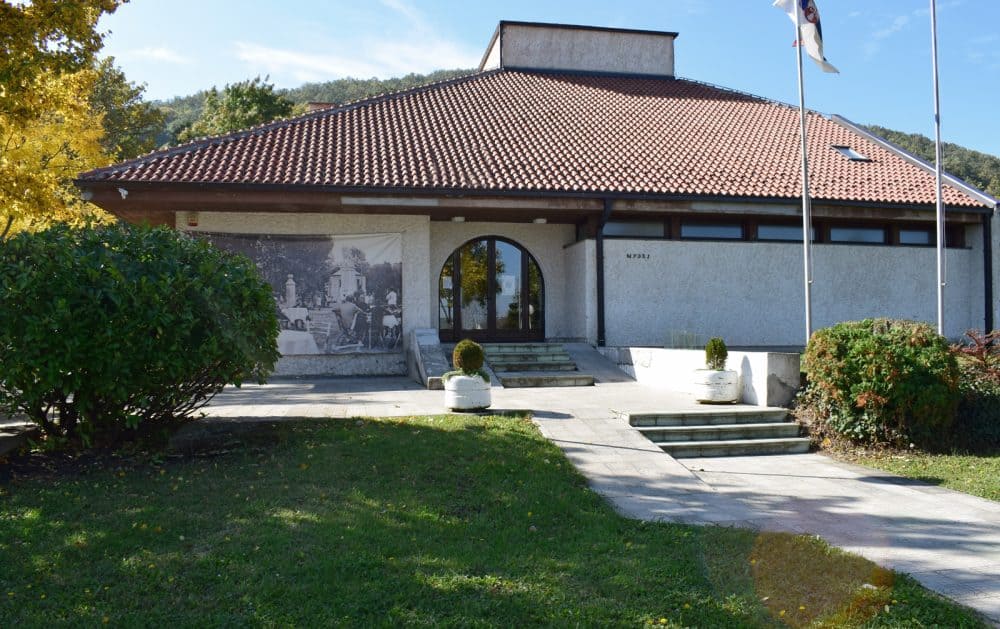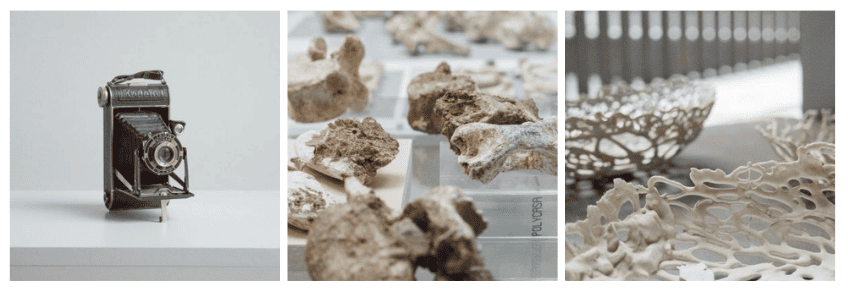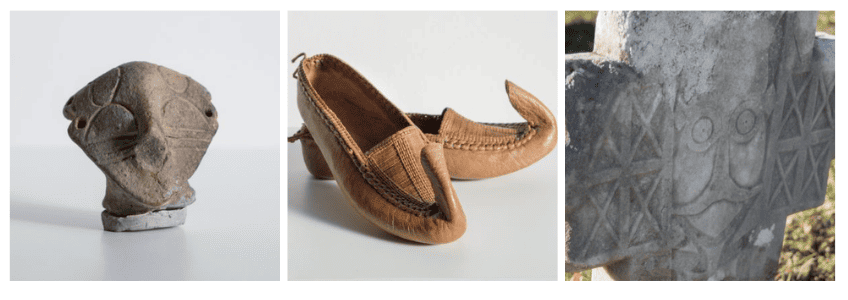About Us
The National Museum in Aranđelovac was founded in 1981 and is located in a purpose-built building whose architecture reflects the traditional folk construction of the Šumadija region (designed by F. Bajlon).
The museum’s primary mission is to research, study, protect, and present movable cultural heritage from the municipalities of Topola and Aranđelovac. It is a multidisciplinary institution that houses collections from the fields of paleontology, archaeology, ethnology, history, art history, and numismatics.
Professional work within the museum is organized into specialized departments for each research and preservation area, and it also includes a Conservation and Restoration Department.
Exhibitions are held in two main spaces: the ground floor, which currently features the permanent exhibition “Millennium,” and the gallery, which displays contemporary ceramic art from the museum’s collection. Additionally, part of the ground-floor space is reserved for thematic and guest exhibitions, enriching the cultural and artistic life of the community.
Sites
The National Museum in Aranđelovac, as the managing institution, is responsible for the care of the protected area “Risovača Cave.” As a significant Paleolithic archaeological site, Risovača has been declared a cultural monument of great importance, and due to its natural features, it is also recognized as a natural monument of exceptional value (a first-category natural monument).
Arranged according to all principles of modern presentation, the site receives over 20,000 visitors annually. The Museum also manages the well-known sites of Orašac, the ossuary, and the Ilija Milošević Garden.
Educational work is one of the key segments of the museum’s curatorial and guide activities. Special attention is given to educational workshops for preschool, elementary, and high school children. In addition, the museum organizes workshops for adults, lectures, and the promotion of museum publications.
The museum is also engaged in publishing activities—catalogs of collections and exhibitions, monographs, guides through the Museum and Risovača Cave, and other publications. In 2003, the Museum launched its own series titled “Šumadija Records.”
Discover the National Museum in Aranđelovac – Where History, Art, and Nature Unite
Step into the heart of Šumadija and explore the rich cultural and natural heritage preserved by the National Museum in Aranđelovac. Founded in 1981, the Museum safeguards the region’s most valuable treasures from prehistoric discoveries to contemporary art and invites visitors of all ages to experience history in a truly engaging way.
As the official manager of the protected area “Risovača Cave”, one of Serbia’s most important Paleolithic sites, the Museum offers an unforgettable journey through the Ice Age. Modernly arranged and interactive, the cave welcomes over 20,000 visitors every year. The Museum also oversees other key heritage sites such as Orašac, the ossuary, and the Ilija Milošević Homestead, where visitors can explore traditional architecture and rural life.
Our exhibitions span across two main spaces the ground floor hosts the permanent exhibition “Millennium”, while the gallery features “The World of Ceramics” and a rotation of thematic and guest exhibitions.
The Educational Department brings history to life through creative workshops, school programs, lectures, and interactive tours. Children and adults alike can participate in hands-on learning experiences, from the traditional Easter Workshop to the popular Museum Children’s Summer program. Our goal is to inspire curiosity and make every visitor an active participant in discovering the past.
Behind the scenes, the Museum’s Documentation Service ensures meticulous care of the collections using modern digital tools like ETERNITAS, while the Library, with over 5,000 professional volumes, supports continuous research and collaboration with related institutions.
Don’t leave without visiting our souvenir shop, where unique gifts and publications including our own series “Šumadija Records” — help keep the spirit of Aranđelovac’s heritage alive.
Explore Our Collections
Explore the Historical Collection section in the Museum’s online gallery and discover unique artifacts that tell the story of Aranđelovac, Topola, and the wider Šumadija region through time.
Explore the Paleontological Collection section in the Museum’s online gallery and discover fascinating fossil remains that reveal the ancient life and natural history of the Šumadija region.
Visit the Art History Collection section in the Museum’s online gallery and explore artworks that showcase the evolution of artistic expression and cultural heritage in the Šumadija region.
Explore the Archaeological Collection section in the Museum’s online gallery and discover artifacts that trace the life, culture, and traditions of people who inhabited the Šumadija region from prehistoric times to the Middle Ages.
Visit the Ethnographic Collection section in the Museum’s online gallery and explore traditional crafts, clothing, and everyday objects that reflect the rich cultural heritage of the Šumadija region.
Explore the Collection of Tombstones section in the Museum’s online gallery and discover historical gravestones that offer insight into the region’s cultural, religious, and artistic traditions.
Millennium Exhibition & Contemporary Ceramics at the National Museum in Aranđelovac
The National Museum in Aranđelovac preserves and displays a vast collection of artifacts in paleontology, archaeology, ethnology, history, and art history, showcasing the material and spiritual culture that developed in this part of Šumadija.
Since March 2, 2011, visitors can explore the permanent exhibition “Millennium”, which guides you through thousands of years of continuous settlement in the Aranđelovac and Topola region. The oldest exhibits illustrate the life of Neanderthal humans, including tools discovered in Risovača Cave. Large displays depict the steppe landscape with mammals from the Paleolithic era, along with life-size representations of Neanderthals. A central highlight of the paleontological section is the skeleton of a cave bear.
The archaeological section presents artifacts from the Neolithic period (6th–5th millennium BC), including items from the Starčevo and Vinča cultures, such as an 8,000-year-old ceramic vessel, anthropomorphic figurines, and a 32-century-old ceramic pot. The exhibition continues through the Copper, Bronze, and Iron Ages, featuring items from Celtic necropolises that reflect the lasting presence of Celts in the region. Roman antiquity is represented by columns and a stone lion, while 26 Late Antique sites in the area demonstrate the presence of Roman rural villas.
The lapidarium displays medieval tombstones and fragments from churches and monasteries, including a 14th/15th-century monument revealing the previously unknown Serbian noble family, Živčić. Most inscriptions are legible, and some feature unique historical penalties.
The history section covers both Serbian uprisings, displaying original weapons such as Tanasko Rajić’s rifle and chainmail worn by rebels. Artifacts from World War I and II include soldiers’ equipment from Thessaloniki and Austro-Hungarian armies, as well as rifles and machine guns. Ethnographic exhibits showcase reconstructed hearths, Šumadija architectural styles, agricultural and livestock tools, and traditional crafts such as shoemaking, tanning, and tailoring. The museum also traces the development of Aranđelovac and Bukovička Banja, with historical photos, carriage permits, spa glasses from the 1930s, cameras, benches, and notable local personalities. Informative legends throughout the exhibition allow visitors to explore independently, while guides and curators are available for expert tours. Educational workshops are being developed to make visits even more interactive and engaging.
Retrospective Exhibition of Contemporary Ceramics
Since January 21, the museum gallery hosts a Retrospective Exhibition of Ceramics from the “World of Ceramics” symposium (1974) as part of the “Marble and Sounds” event. The museum’s collection of about 600 pieces is one of the richest in Europe. This exhibition features 54 artists who shaped contemporary ceramic art, establishing its status alongside other visual arts in Serbian and former Yugoslavian art.
Selected works from renowned international artists—including Merily Opperman (Brazil), André Willox (Belgium), Federico Bonaldi (Italy), Tadej Bratelj (Slovenia), Gamal Eldin Ahmed Abud (Egypt), and Panduranga Daroz (India)—are also on display. Notable Serbian artists include Mirjana Isaković, Mirko Orlandini, Velimir Vukićević, Tijana Dujović, Ana Popov, as well as younger talents like Biljana Lane Rakanović, Larisa Ackov, and Ivana Rackov.
This exhibition offers a unique journey through history and art, combining millennia of local heritage with the vibrant creativity of contemporary ceramics.
You can find more information about the National Museum in Aranđelovac here.





